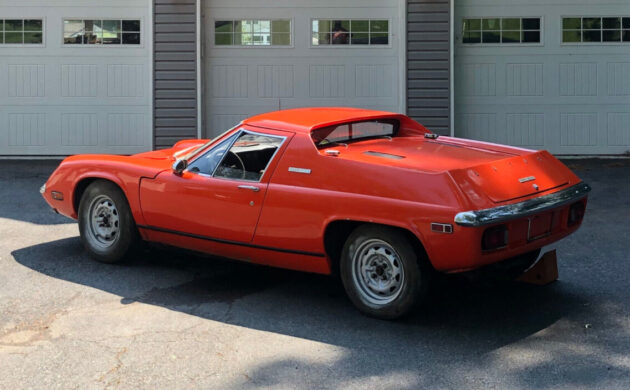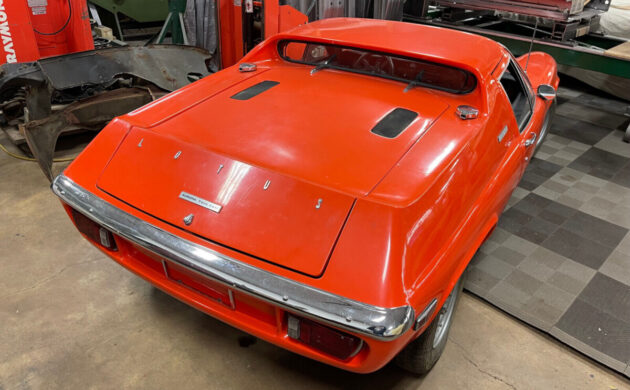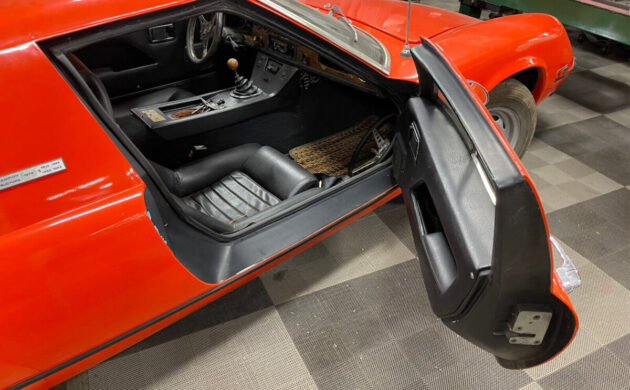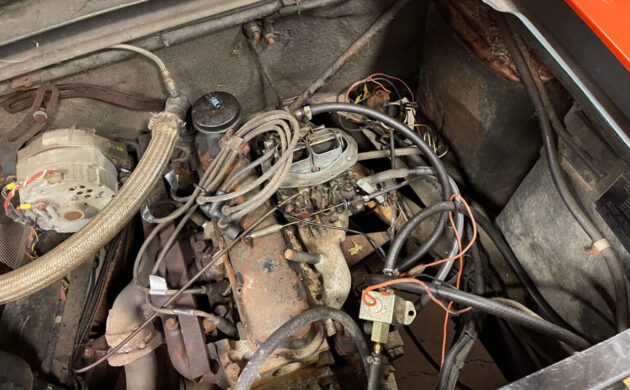When Colin Chapman sat down to design sports cars, his primary goal was to make the vehicle light as possible. While others were adding weight in the name of horsepower and the braking, wide wheels and tires, beefed up suspension and brakes need to go along with all of that, Chapman was devising what the bare minimum was to get the job done. This 1973 Lotus Europa for sale on eBay in Elkton, Maryland is a perfect example of this philosophy. With bidding currently at $10,500, how much would you pay for this less is more sportscar with “bread van” styling?
By the dawn of the sixties, everyone in motorsports could see that placing the engine between the wheels was the future of racing. This was even evident in the United States at the Indianapolis Motor Speedway. While there had been previous entries that did not follow the “roadster” front engine concept that dominated Indy, Jack Brabham showed up with an underpowered mid-engined Cooper of his design in 1961. He placed ninth but could have finished several positions higher if not for some slow pit stops. Jim Clark won 1965 Indy 500 in a Lotus-designed race car with a Ford engine mounted in the middle. 1964 would be the last year that a front-engined car won the Indy 500, and 1968 was the last year that one qualified for the race.
While the dinosaurs were watching the comet streak across the sky in the United States, Colin Chapman was preparing for his next great achievement: a mid-engine street car. Others were busy designing what we would later term supercars to sell to the public, but Chapman’s genius was placing the car at a price point that most enthusiasts could afford. When Lotus’s Europa premiered in 1966, it was a revolutionary achievement. Even Chevrolet (read: Zora Arkus Duntov) wanted a mid-engined car, but couldn’t find a way to produce it profitably. Chapman found a way to do it.
Of course, the Europa followed the Lotus tradition of letting the customer be the final testers. Chapman used his ingenious folded steel backbone frame design on the car but initially bonded it to the fiberglass body for enhanced chassis rigidity. That soon changed to more conventional bolting of the body onto that frame. Customers had discovered just how impossible it was to repair the car after an accident. Lotus initially produced the car with a Renault 16 engine and transmission. When they switched to Ford engines later, they soon found that they needed to strengthen the Renault transmission required because of the car’s drivetrain layout.
Add in all of the other issues you have with fit and finish and the inherent difficulties that a small manufacturer has sourcing parts from multiple makers to produce a car of their own. Lotus simply wasn’t big enough to produce every component in-house, so these compromises caused some issues. To those customers eager to experience the sublime handling that the car delivered, these negatives were worth putting up with. They would find a way to refine the car, keep it running, and even store spare parts if necessary. Chapman’s concept was a sound one, even if it took some additional effort to experience it.
The Lotus Europa you see here is a perfect example of how a Lotus enthusiast compromises to experience that magical Lotus handling. This is a non-running project car that has not only all of the parts and pieces but also comes with a fair number of extras as well. Starting the ad, the seller tells us that they are unsure as to whether this was originally a four-speed or a five-speed car. Furthermore, we are told that the twin-cam engine comes with the car. That engine is out of the car and will likely require rebuilding. What you see in the picture above is believed to be a Ford “Kent” engine placed there to keep the car on the road after the twin-cam was removed. That happened somewhere around 1985, which was when the car was last on the road.
We are told that the car was stored indoors since then. When the seller purchased the car from the previous owner’s estate, it also came with several spare parts ranging from twin-cam engine components to two additional frames. The seller believes that this car could be returned to the road with little trouble. It rolls and steers with no issue, and there are no indications that there is anything wrong with the engine that a little maintenance wouldn’t cure. It is a project though, but a very good one to start with if you want a Lotus of this type.
Have you ever owned a Europa or any other Lotus vehicle? Is the legendary handling worth the cost of admission? Please share your thoughts in the comments.













That certainly doesn’t look like the R16 engine> I have some experience with those and, except that they don’t exactly deliver pavement-shredding performance, are reliable, easy to service/repair/rebuild and do well in the lightweight Europa.
I believe — but and not sure — all pre-Twin Cam Europas had the four-speed Renault box. Swapping for the five-speed isn’t that difficult, though I believe some welding would be needed to fit the rear trans. mount to a Lotus.
The more I look at the photos, the more I think this one started out as a Twin Cam. All the Renault-engine cars had the larger “sail” panels on the rear quarters.
Agree. That’s the Ford engine. The notched rear bodywork was introduced with the twin cam engines. Still miss the two I had. Got to be too many cars at one time.
Definitely started out as a Twin Cam. 73’s were the newer series especially with the rear sail panels having the new lowered look for more visability. Never owned one but drove them and spent much time at a friends Lotus dealership in NJ in early 70’s. Some one is just trying to save this car the best he could.
Jeff – ‘breadvans’ are the Europas with the high sails, and indeed, as noted above, they all had Renault engines. Lowered sails indicate this was a Twin Cam. And yes, that is a Ford ‘Kent’ engine. Worked on lots of them in the Ford Cortinas and early Pintos.
I love that alternator mount. Europas always ran the alternator off the back of the engine (both Renault and Twin Cam). Took some real work to install the alternator at the front of the engine. A Europa has no space there.
Still have my Twin Cam.
Almost bought an S2 with a Ford engine with the twin cam Kent head on it. Forgot the hp but it was fast!
Gotta love that rattle-can wheel refinish, accomplished without that bothersome masking tape for the tires.
How could you check out how it handles, they never run!
There isn’t anything complicated here so it shouldn’t be hard to get it running again.
Wrong, they always run when you are headed away from home. Its only when you want to go back that they give you trouble. Wonderful little car for an owner with lots of friends, especially ones with car trailers or roll-backs.
I had two. They were truly horrible. And I truly loved every second of having them.
I had a 1969 years ago, wish i still had it. The sale ended, looks like they sold it off of FeeBay.
Sale ended.
i’ve owned every sports car on the planet and none are as much fun as a Europa. Best handling ever.
Just an after thought, I spend man, many hours contemplating the installation of a For 2.6 v6 from a wrecked Capri inn mine. I was told that the motor would bolt up to the lotus bellhousing like it was designed to be there. I was also told that the cooling would be marginal. I was concerned about the strength of the “S” five speed. I got as far as buying the motor. Then my wife suggested that perhaps we had better things to spend out meager salaries on. As always, she was right.